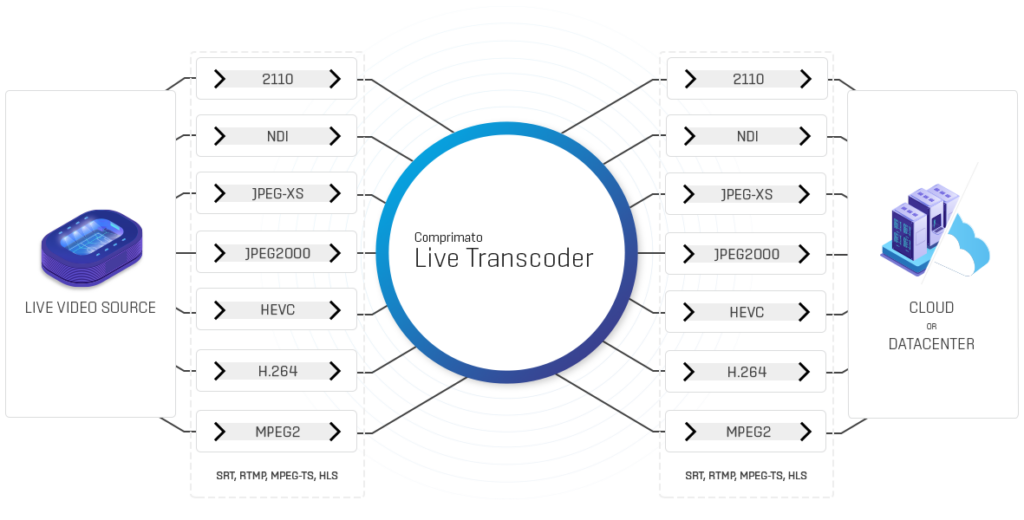Emerging Live Video Formats and Codecs: Bridging the Future of Live Production
As live video production evolves, the need for adaptable, high-performance solutions has become paramount. The industry faces challenges with fragmented IP video infrastructures and competing standards, making it essential to adopt software-defined solutions that unify workflows and deliver broadcast-grade performance.
The Role of ST 2110-20 and Compressed Formats
In the world of IP-based live production, SMPTE ST 2110-20 has become the industry’s standard for RAW, uncompressed video transport. This format preserves pristine image quality and is widely adopted in broadcast environments that require the highest fidelity possible. However, RAW video transport demands high bandwidth, making it costly and challenging for some applications.
To optimize infrastructure costs and improve efficiency, compressed IP video formats like ST 2110-22, NDI, IPMX, and Dante AV have emerged, offering low-latency, high-performance alternatives. These formats reduce bandwidth consumption while maintaining visual quality, enabling scalability for cloud-based and hybrid workflows.
Let’s explore how these compressed formats are shaping the future of live video production.
The Growing Complexity of IP Video Infrastructures
The IP video landscape offers exciting opportunities but presents significant challenges:
- Fragmentation across competing formats leads to interoperability issues.
- Vendor lock-in that restricts flexibility and increases costs.
- The high complexity of implementing and managing these technologies.
Despite these challenges, emerging formats and codecs enable a more interconnected and flexible future for live production workflows. Let’s explore how these technologies are transforming the industry.
NDI: Cost-Effective Plug-and-Play Video Transport
NDI (Network Device Interface) is a widely adopted format due to its simplicity and affordability, making it an excellent choice for:
- Cloud-based production workflows.
- On-premise use cases, such as video calls, monitoring, and isolated workflows.
Built on codecs like SpeedHQ, H.264, and HEVC, NDI offers low infrastructure requirements and a plug-and-play experience. However, it lacks robust flow management and telemetry tools, creating opportunities for software solutions to enhance its efficiency and integration into larger systems.
Key Benefits of NDI:
- Cost-effective and easy to deploy.
- Ideal for hybrid workflows combining cloud and on-premise operations.
- Supports HDR and 10-bit video for high-quality production.
ST 2110-22: Transforming Broadcast Workflows
ST 2110-22 is part of the SMPTE ST 2110 suite, designed to enable the transport of compressed video. It provides:
- Codec agnosticism, supporting JPEG-XS, HTJ2K, and other formats.
- Low latency for seamless live workflows.
- Flexibility for both on-premise and cloud-based production environments.
This standard significantly reduces infrastructure costs and complexity while maintaining the quality and precision required for professional live broadcasts. Software solutions further enhance its capabilities by enabling format interoperability and real-time transcoding.
Why Choose ST 2110-22:
- Reduces hardware costs with compressed video transport.
- Ensures compatibility with established broadcast workflows.
- Adapts to evolving production needs with codec flexibility.
IPMX: Bridging Pro AV and Broadcast
IPMX is a royalty-free standard built on the foundations of ST 2110. It is designed to simplify Pro AV workflows with:
- Plug-and-play functionality akin to HDMI.
- Simplified timing infrastructure, making PTP optional.
- Features like HDCP 2.3 encryption and USB virtualization for KVM applications.
While IPMX is still a growing ecosystem, its potential to merge Pro AV and broadcast workflows makes it a cost-effective and forward-thinking solution for hybrid environments.
Advantages of IPMX:
- Open and royalty-free standard with broad potential for adoption.
- Cost-efficient compared to more complex broadcast standards.
- Ideal for hybrid Pro AV and broadcast applications.
Dante AV: Precision and Centralized Control
Building on Audinate’s expertise in audio networking, Dante AV combines precise timing with centralized management. It supports codecs like JPEG2000 and H.264, making it a strong choice for:
- Hybrid audio-visual workflows, both on-premise and in the cloud.
- Applications requiring precise synchronization.
Dante AV excels in centralized flow management but relies on proprietary technology. This creates opportunities for software-defined solutions to bridge integration challenges and enhance interoperability.
Why Dante AV Matters:
- Delivers precise AV synchronization for professional workflows.
- Simplifies management with centralized control.
- Broad codec support ensures flexibility across diverse environments.
Bridging the Gaps with Software
The growing complexity of live video formats demands solutions that unify fragmented infrastructures and enable seamless workflows. Software-defined solutions are at the forefront of this transformation by:
- Supporting a wide range of codecs and formats.
- Enabling real-time transcoding and format conversion to ensure interoperability between different standards.
- Reducing reliance on proprietary hardware, lowering costs, and simplifying deployment.
One of the key advancements in this space is the rise of virtualized software encoders. These encoders play a vital role in:
- Supporting virtualized and cloud workflows, enabling flexibility in production environments.
- Addressing diverse production needs, seamlessly handling transitions between formats.
- Bridging the islands of different IP infrastructures, creating unified workflows across various standards and codecs.

Software not only addresses current challenges but also bridges the gap between on-premise and cloud workflows, offering a future-proof approach to live production. With flexible, virtualized solutions, production teams can adapt to evolving technologies without compromising on quality or performance.
The Path Forward: Open Standards and Software Innovation
The future of live video production lies in embracing open and royalty-free standards like ST 2110 and IPMX. By adopting these technologies and leveraging the power of software-defined solutions, production teams can accelerate innovation, simplify workflows, and unlock new possibilities.
Software’s ability to connect fragmented infrastructures, reduce complexity, and scale with ease makes it an essential part of the modern production ecosystem.
Final Thoughts
While SMPTE ST 2110-20 remains the industry standard for uncompressed RAW video, the rise of compressed alternatives like ST 2110-22, NDI, IPMX, and Dante AV enables cost-efficient, scalable, and software-driven production workflows.
The key to navigating this landscape is understanding when to use RAW and when compressed formats are more efficient—and having the right software tools to bridge them together seamlessly.The future of live video production is flexible, software-driven, and more connected than ever.
